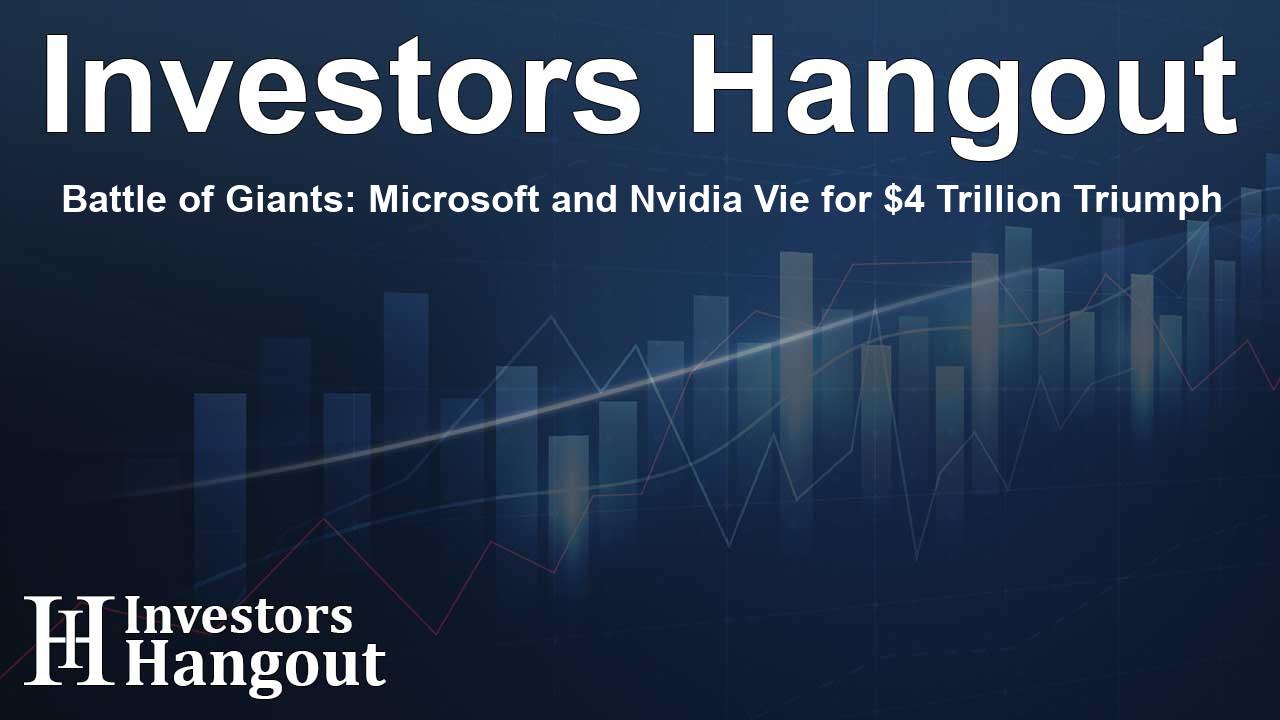Battle of Giants: Microsoft and Nvidia Vie for $4 Trillion Triumph

Microsoft and Nvidia's Race to $4 Trillion
In the competitive landscape of technology, Microsoft (NASDAQ: MSFT) and Nvidia (NASDAQ: NVDA) are frantically pushing towards a remarkable $4 trillion market cap. Analysts are excitedly forecasting that these two titans will lead the charge, marking a significant moment in business history.
Introduction
Both companies are redefining what it means to lead in the artificial intelligence sector, having already crossed the $3 trillion threshold. This article delves into their current standings, the rapid developments that have brought them here, and what may lay ahead as they strive for the coveted title of the world’s most valuable enterprise.
Success Stories of Microsoft and Nvidia
Microsoft has undergone a substantial transformation from its origins as a software conglomerate. By harnessing the power of its Azure cloud computing platform, Microsoft is now recognized as a formidable player in the AI domain. This pivot toward AI has led to an impressive revenue growth, with their services segment soaring to $54.7 billion recently, a notable increase from the previous $44.8 billion.
Nvidia's journey has been nothing short of phenomenal as well. The launch of ChatGPT at the end of 2022 sparked a surge in demand for AI technology, with Nvidia's graphics processing units (GPUs) becoming the industry standard for running advanced AI applications. Over four years, Nvidia's market value has skyrocketed from $500 billion to the approaching $4 trillion, driven by demand for AI chips that establish it as a critical partner for top companies, including Microsoft.
Comparing Financial Performance: MSFT vs. NVDA
When examining their financials closely, both tech giants exhibit unique strengths. Microsoft boasts a forward P/E ratio of 33.22, a profit margin of 35.79%, and total annual revenue of $270.01 billion. Its financial health is evident with $79.62 billion in cash and manageable debt levels.
Conversely, Nvidia showcases even more remarkable growth metrics. It comes with a forward P/E ratio of 37.17 and a stellar profit margin of 51.69%, generating revenue of $148.51 billion. Remarkably, Nvidia's return on equity stands at a striking 115.46%, significantly outpacing Microsoft's 33.61%. While Nvidia has posted year-to-date gains of 18.67%, its five-year return is a jaw-dropping 1,563.14%. The company is also in a strong cash position with $53.69 billion available and minimal debt.
Market Sentiment and Analyst Recommendations
Analysts on Wall Street maintain an optimistic outlook for both companies but highlight different strengths. Microsoft's average analyst price target stands at $522.26, which indicates a modest upside from current trading levels. Strong ratings from financial institutions reflect confidence in Microsoft’s established framework that blends stability with AI growth potential.
Nvidia, however, attracts even more enthusiastic analyst projections, with price targets averaging $173.92. Despite presenting a lesser upside from its current valuation, the strong endorsement from analysts reflects deep confidence in Nvidia's innovation in AI technology. While some express concern over the sustainability of current AI valuations, the potential for substantial return remains attractive.
The Path to $4 Trillion: Who Will Prevail?
Considering their respective positions, Nvidia appears to be on a faster track to hitting the $4 trillion milestone. Its leadership in AI chip production, along with its central role in the infrastructure needed for AI applications, provides it with a unique edge. The impressive profit margins and growth trajectories position Nvidia well for sustained valuation increases.
Nonetheless, Microsoft’s diversified business model offers a more stable long-term approach to reaching and surpassing $4 trillion. The ongoing success of Azure serves as a vital component of this growth, creating benefits that cater to the burgeoning demand for AI globally. While Nvidia may likely cross the $4 trillion finish line first, Microsoft's comprehensive ecosystem and revenue diversification set a robust foundation for future growth, potentially positioning it favorably towards the $5 trillion milestone in time.
Frequently Asked Questions
What are the main factors driving Microsoft's growth?
Microsoft's shift to AI via its Azure platform and successful cloud services have led to significant revenue growth, underscoring its competitive edge in the tech landscape.
How has Nvidia impacted the AI industry?
Nvidia's advanced GPUs have become essential for AI applications, positioning the company as a key enabler of AI technology growth across various sectors.
What financial metrics highlight their competition?
Microsoft shows a stable growth trajectory with strong profiting margins, while Nvidia's extraordinary return on equity and revenue from AI chips reflects its volatile but rapid growth.
Are there concerns regarding Nvidia's growth sustainability?
Yes, some analysts express caution about AI valuations and the uncertainty of sustained demand for Nvidia’s products in the future, which could impact its stock performance.
Which company is projected to reach $4 trillion first?
Current trends suggest that Nvidia may achieve the $4 trillion milestone first due to its market leadership and rapid growth in the AI segment.
About The Author
Contact Dominic Sanders privately here. Or send an email with ATTN: Dominic Sanders as the subject to contact@investorshangout.com.
About Investors Hangout
Investors Hangout is a leading online stock forum for financial discussion and learning, offering a wide range of free tools and resources. It draws in traders of all levels, who exchange market knowledge, investigate trading tactics, and keep an eye on industry developments in real time. Featuring financial articles, stock message boards, quotes, charts, company profiles, and live news updates. Through cooperative learning and a wealth of informational resources, it helps users from novices creating their first portfolios to experts honing their techniques. Join Investors Hangout today: https://investorshangout.com/
The content of this article is based on factual, publicly available information and does not represent legal, financial, or investment advice. Investors Hangout does not offer financial advice, and the author is not a licensed financial advisor. Consult a qualified advisor before making any financial or investment decisions based on this article. This article should not be considered advice to purchase, sell, or hold any securities or other investments. If any of the material provided here is inaccurate, please contact us for corrections.
